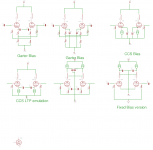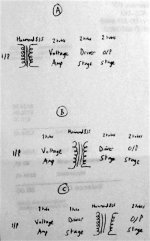Member
Joined 2009
Paid Member
I have a pair of these transformers and wonder how best to use them. Hammond calls them inter-stage, but they don't allow any unbalanced dc current through them ?
http://www.hammondmfg.com/pdf/5c0047-48.pdf
http://www.hammondmfg.com/pdf/5c0047-48.pdf
There are ways of forcing current balance in LTP drivers. What i couldn't see was their voltage capability and their inductance. Those are the critical indicators of whether they will work as a valve interstage or whether they are only suitable for transistor applications.
Shoog
Shoog
Member
Joined 2009
Paid Member
Max power level is 0 dbm which is as I said equivalent to 1mW of drive power. First page fourth line.
This might make it suitable for an easy output valve or between a preamp valve and a driver, but it strikes me it would crumble under AB load which is what you want from a good interstage.
Of course I could be completely wrong on this.
EDIT: OK I see that the 835 is on the second page and you are right that it takes +15dbm which makes 15mW of drive power.
Shoog
This might make it suitable for an easy output valve or between a preamp valve and a driver, but it strikes me it would crumble under AB load which is what you want from a good interstage.
Of course I could be completely wrong on this.
EDIT: OK I see that the 835 is on the second page and you are right that it takes +15dbm which makes 15mW of drive power.
Shoog
Last edited:
OVDC can be achieved with 2CCS, one in each tail of your driver.
Alternatively a Wilson Current mirror in the tails will do it.
Blumfelds garter Bias will also do it.
Each of these can be bypassed with a cap from each cathode to ground, or a cap between the two cathodes to emulate LTP behaviour.
Another approach is to put two CCS's, one for each primary winding, with bypass caps to ground at the bottom of the CCS but before the winding. Keep the windings unlinked.
I have applied all of these techniques to output stages and each has worked flawlessly.
Shoog
Alternatively a Wilson Current mirror in the tails will do it.
Blumfelds garter Bias will also do it.
Each of these can be bypassed with a cap from each cathode to ground, or a cap between the two cathodes to emulate LTP behaviour.
Another approach is to put two CCS's, one for each primary winding, with bypass caps to ground at the bottom of the CCS but before the winding. Keep the windings unlinked.
I have applied all of these techniques to output stages and each has worked flawlessly.
Shoog
Member
Joined 2009
Paid Member
Thanks Shoog - I will have to think about some circuit options
If it would be useful I can sketch the ideas I outlined to avoid confusion.
Shoog
Member
Joined 2009
Paid Member
I'd be interested to see your sketches - but should be honest that I won't be building anything in the near future due to a backlog of unfinished projects!
But if these transformers are useful maybe others here too would be interested in some fresh ideas ?
I was also wondering about a hybrid, using a tube driver into a trafo and have the trafo provide the phase splitting into a pair of MOSFETs (I think I saw something like this labelled amplimos once).
But if these transformers are useful maybe others here too would be interested in some fresh ideas ?
I was also wondering about a hybrid, using a tube driver into a trafo and have the trafo provide the phase splitting into a pair of MOSFETs (I think I saw something like this labelled amplimos once).
Member
Joined 2009
Paid Member
A friend and I had a bench test RCA BA-6 limiter circuit built, in which we tested and measured various input, interstage and output transformers, including original RCA, modern clone replacements, and various others to see what would perform properly. The Hammond 835 did fine. We gave no special attention to 6SK7 current matching. Real time measured response in Spectrafoo with both music and pink noise showed no low frequency anomalies, and sound with program audio was good to the ear with no apparent distortion greater than heard with known good substitutes such as the Sowter clone, or the Gates Dual Limiter interstage. Another note, with multiple examples to measure, the 835 greatly exceeds the published response spec, and handle a wide range of source Z, including matching condition. Inductance measures very high with a handheld meter at 120Hz. FWIW, YMMV.
Member
Joined 2009
Paid Member
I would use parafeed and avoid trying to match CCS circuits. I've had CCS's drift before.
An externally hosted image should be here but it was not working when we last tested it.
I cannot agree since you have halved the efficiency of an already inefficient circuit in this setup.
I have never had a CCS drift to any significant degree after years of daily use.
Shoog
Member
Joined 2009
Paid Member
Where's the best place to use this Hammond 835 if it is to be used as a phase-splitter in a Push-Pull amplifier ?
A) at the input, driven by the source ?
B) after the voltage amp before the driver stage ?
c) after the driver stage to the grids of the output tubes ?
A) at the input, driven by the source ?
B) after the voltage amp before the driver stage ?
c) after the driver stage to the grids of the output tubes ?
Attachments
- Status
- This old topic is closed. If you want to reopen this topic, contact a moderator using the "Report Post" button.
- Home
- Amplifiers
- Tubes / Valves
- using a Hammond 835 interstage ?


